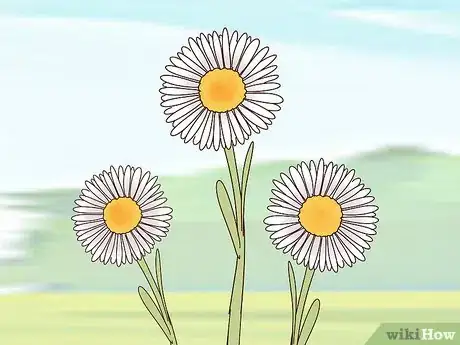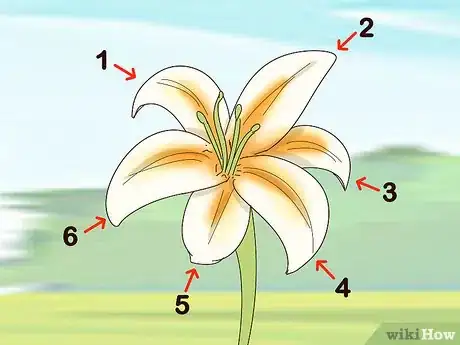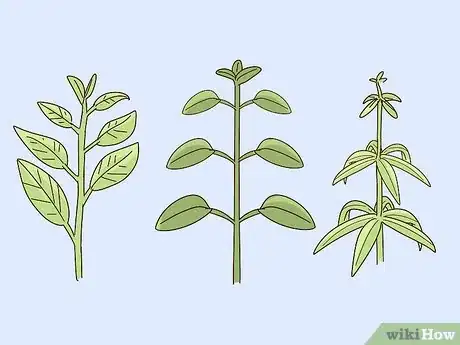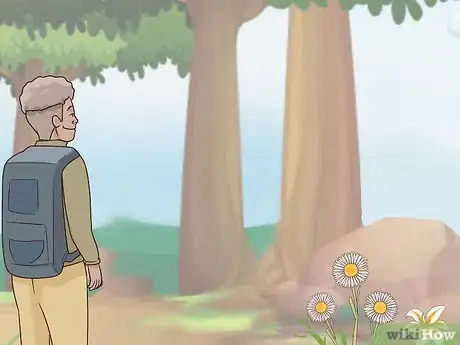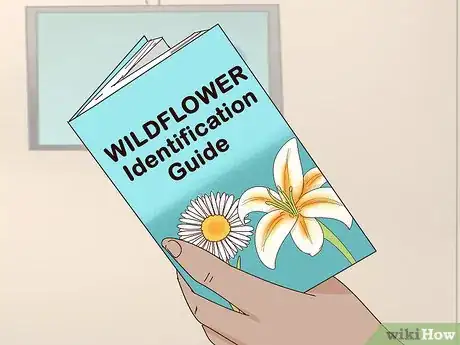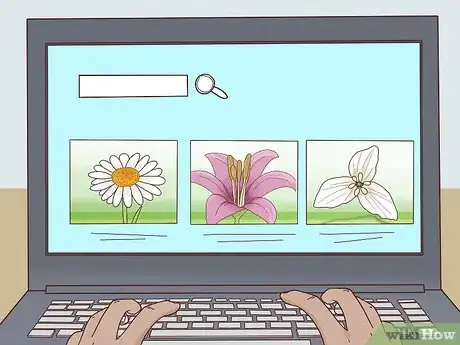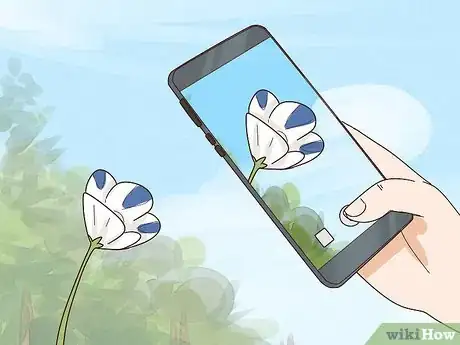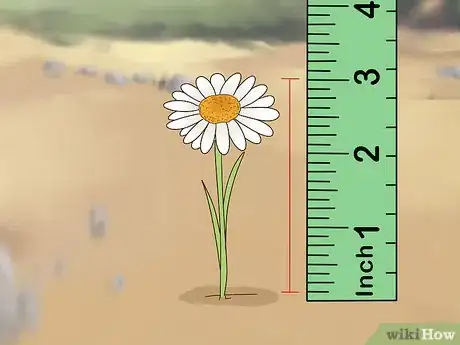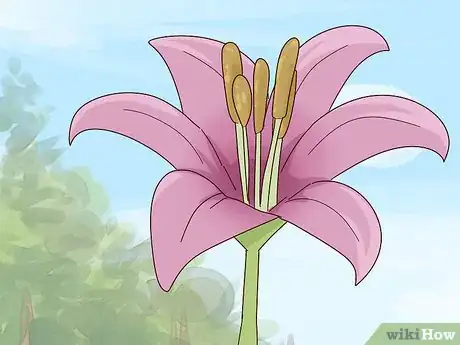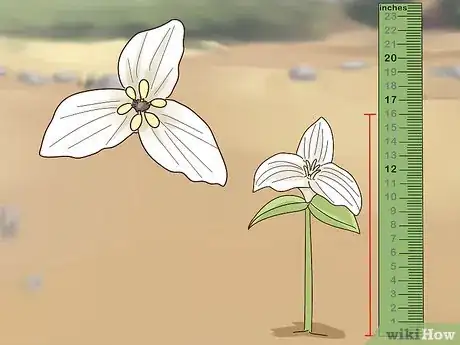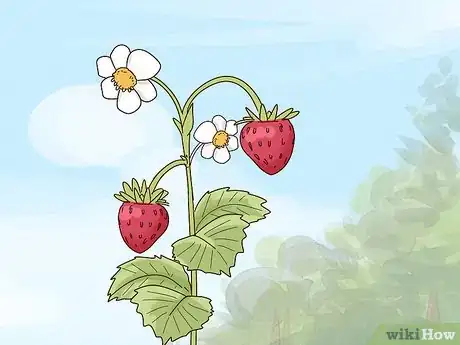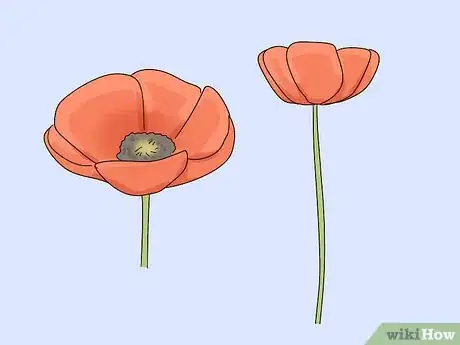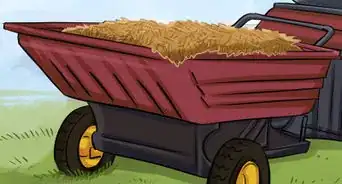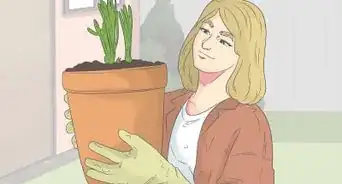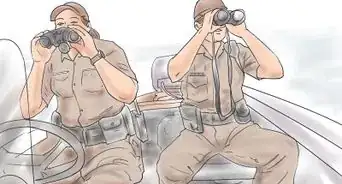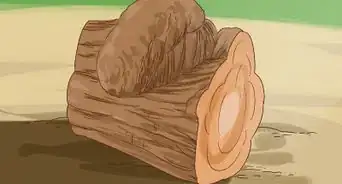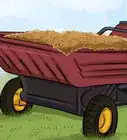This article was co-authored by Michael Simpson, PhD. Dr. Michael Simpson (Mike) is a Registered Professional Biologist in British Columbia, Canada. He has over 20 years of experience in ecology research and professional practice in Britain and North America, with an emphasis on plants and biological diversity. Mike also specializes in science communication and providing education and technical support for ecology projects. Mike received a BSc with honors in Ecology and an MA in Society, Science, and Nature from The University of Lancaster in England as well as a Ph.D. from the University of Alberta. He has worked in British, North American, and South American ecosystems, and with First Nations communities, non-profits, government, academia, and industry.
There are 13 references cited in this article, which can be found at the bottom of the page.
This article has been viewed 16,396 times.
Identifying wildflowers is a great way to learn more about nature, especially when hiking, camping, or even gardening in your backyard. When you find a wildflower, take note of the color, size, shape, and number of its petals and leaves. Use identification books, websites, and apps to help you identify the particular specimen. With some attention to detail and research, you can easily learn to recognize wildflowers in your area.
Steps
Looking for Identifying Markers
-
1Look at the overall color of the flower.[1] Notice the petal color of the flowers for an easy way to differentiate it from other wildflowers. For instance, is the flower white? Bluish purple? Red? Other common wildflower colors include pink, yellow, orange, maroon, and green.[2]
- For example, the longleaf aster has white flowers with a yellow center.[3]
- The silvery lupine has purple flowers and a hairy legume pod in a cone-like shape. A legume pod is the part of the plant that houses the seeds.
-
2Count the number of petals if the flower has them.[4] When you find a wildflower, notice how many petals it has overall, based on the shape of the plant. Does it have 3 evenly-spaced petals or more than 6 radial petals? Each flower type has its own distinct petal composition, so this is an effective way to differentiate between wildflowers.[5]
- For example, lily species commonly have 6 evenly-spaced petals.
Advertisement -
3Take note of the shape, size, and arrangement of the leaves.[6] Leaves can be absent, alternating, basal, opposite, or whorled. The leaf shape is also important, as they can be heart/round shaped, linear, wider near the base, wider near the middle, or wider near the tip. Examine the stem and leaves of the wildflower you find to help you identify it.[7]
- For example, wild strawberry plants usually have small, compact leaves with jagged edges. The leaves form a 3-leaf cluster.
- If the plant has no leaves, it has an absent leaf structure. Opposite leaves refer to the leaf pattern where there are 2 leaves on opposite sides of the stem.
- Basal leaves are attached to the stem in pairs or clusters.
- Whorled leaves radiate around the stem in a clustered, multi-leaf pattern.
-
4Consider the location, climate, and season when you find the flowers. Your location has a lot to do with what wildflowers are available in your area. Some flowers only grow in certain areas, and some flowers only bloom during certain times of the year. There are some common flowers found in a variety of climates, such as different types of lilies.[8]
- You can find wildflowers including coneflowers, poppies, sage, and common marigold across the globe.
- For instance, Mount Diablo buckwheat is a pink flower only found in California. Until 2005, it was considered extinct.[9]
Using Identification Tools
-
1Use a wildflower identification book to find the species while in nature. While you are exploring the great outdoors, bring a small trail book with you to help easily identify flowers as you find them. This is a fun, exciting way to spend time in nature. Wildflower books are often sorted by region, color, and leaf type. They usually include colored photos or illustrations to help you pick out the flowers you find.[10]
- You can also snap a photo of the flower and use a book when you get home.
-
2Search online for a plant database to identify the flower from home. In addition to book reference guides, you can also easily use Internet references. Search for “wildflower identification sites” and browse your options. Some sites allow you to click the color, petal number, and location to help narrow down your choices.[11]
- This is a great idea if you have used a reference book and are still unsure of the flower you found.
-
3Use an app to identify various flowers on the go. Search on your app store to find an app to use. There are both free and paid versions available for most smartphone devices. Ensure the app you select covers the area where you live, as some of the apps have regional plant databases. Then, snap a photo, upload it to the app, and instantly find out the flower type.[12]
- While this is a growing option, most apps do not have information on every type of wildflower.
- Make sure your lens is clean when taking the photo. It is helpful to get the entire flower in the shot.
-
4Do a reverse-image search to instantly and easily identify the flower. If you don’t have any reference guides on you while in the woods, use your smartphone to take a reference photo. Try to capture petals, stem, and leaves of the plant in your photo. Then, visit a search engine, and drag and drop your image into the search bar and select "Search for this image." If the photo is recognized, the type of wildflower will display in your search results.[13]
- You can do this from a computer or a smartphone device.
- For example, snap a picture of that pinkish purplish flower you find when hiking in Greenland. Then, upload the image to a search engine. You'll find the name of the flower as well as information and facts about the species, like that it is the national flower of Greenland.[14]
Recognizing Common Wildflowers
-
1Identify wild daisies by their radial white flowers and yellow center. Daisies grow in every continent aside from Antarctica. Many small, linear, white flowers grow from the same stem, and their leaves are linear and grass-like. Typically, their leaves are a medium shade of green. Most daisies grow in groups about 2–3 in (5.1–7.6 cm) tall and 1–2 in (2.5–5.1 cm) feet wide.[15]
- The leaves on wild daisies are usually dark green.
- These plants are very adaptable, making it easy for them to grow in nearly every country.
-
2Know wild lilies by their 6-petal structure and brown stamen. You can find over a dozen lily species across the world. These types of wildflowers also come in a wide variety of colors, from whites and yellows to purples and oranges. While color may not be a ruling factor, the linear shape of the petals and the brown stamens are sure giveaways that you found a type of lily. Lilies typically have skinny, linear, bright green leaves, and the plants vary in size based on particular species.[16]
- You can find varying species of wild lilies all across the world. In particular, they grow well in temperate, tropical areas in Europe, Asia, and North America.
- Glacier lilies are bright yellow and face upside down.
- Leopard lilies are spotted brown and yellow.
-
3Recognize Trilliums by their large, bell-shaped flower. Trillium flowers come in a variety of colors, including white, maroon, yellow, and pink. There are over 40 species found across the globe. These flowers commonly have a yellow center and bell-shaped leaves. These plants commonly grow between 12–16 in (30–41 cm) tall. Trillium leaves are usually medium to dark green in color.[17]
- For instance, the painted trillium has a maroon “V” that looks painted onto the petals.
- Trilliums grow throughout most of the United States, Canada, and East Asia.
-
4Identify wild strawberries by their 5 small white petals. Wild strawberries are an easy-to-spot springtime flower found throughout the world. In the spring, you can recognize the plant by their white petals and jagged leaves. Trillium leaves are typically triangular in shape. The leaves are usually in groups of 3, and they have a green top and pale green bottom. The leaflets each grow to about 3 in (7.6 cm) long and 1.5 in (3.8 cm) in wide.[18]
- In the late summer, the flowers turn into delicious red berries.
- You can find wild strawberries in many countries across the Northern hemisphere, including most of Europe and North America.
-
5Pick out the common wild yarrow by its clusters of small flowers. Yarrow plants grow throughout North America, Europe, Asia, Australia, Africa, and South America. These plants prefer ample sunlight and can grow in many different environments. Yarrow flowers are most commonly white or yellow, and each blossom consists of small, circular petals. They grow long stems with minimal, linear leaves, and the flowers always form in clustered groups.[19]
- The overall size of the plant depends on the particular species. In general, wild yarrow plants grow to 2–4 ft (0.61–1.22 m) tall.
-
6Notice wild poppy flowers by their overlapping red-orange flowers. Wild poppy plants predominantly grow throughout Asia and Europe, though you can also find them throughout North America. These plants grow in large groups, and they have circular, brightly-colored petals with a dark center. Poppies have skinny stems with minimal, jagged leaves. When mature, poppy plants grow to about 3 ft (0.91 m) tall.
- Some species of poppies have yellow flowers with a yellow center, so keep an eye out for these as well.
Expert Q&A
-
QuestionHow can I find out what kind of flower I have?
 Michael Simpson, PhDDr. Michael Simpson (Mike) is a Registered Professional Biologist in British Columbia, Canada. He has over 20 years of experience in ecology research and professional practice in Britain and North America, with an emphasis on plants and biological diversity. Mike also specializes in science communication and providing education and technical support for ecology projects. Mike received a BSc with honors in Ecology and an MA in Society, Science, and Nature from The University of Lancaster in England as well as a Ph.D. from the University of Alberta. He has worked in British, North American, and South American ecosystems, and with First Nations communities, non-profits, government, academia, and industry.
Michael Simpson, PhDDr. Michael Simpson (Mike) is a Registered Professional Biologist in British Columbia, Canada. He has over 20 years of experience in ecology research and professional practice in Britain and North America, with an emphasis on plants and biological diversity. Mike also specializes in science communication and providing education and technical support for ecology projects. Mike received a BSc with honors in Ecology and an MA in Society, Science, and Nature from The University of Lancaster in England as well as a Ph.D. from the University of Alberta. He has worked in British, North American, and South American ecosystems, and with First Nations communities, non-profits, government, academia, and industry.
Registered Professional Biologist A good place to start when trying to identify wildflowers is by looking at the flowers themselves. Some field guides separate species by flower color, which can be a handy shortcut when you are trying to narrow the plant you have to a list of possible species.
A good place to start when trying to identify wildflowers is by looking at the flowers themselves. Some field guides separate species by flower color, which can be a handy shortcut when you are trying to narrow the plant you have to a list of possible species. -
QuestionHow can I identify multi-colored flowers?
 Michael Simpson, PhDDr. Michael Simpson (Mike) is a Registered Professional Biologist in British Columbia, Canada. He has over 20 years of experience in ecology research and professional practice in Britain and North America, with an emphasis on plants and biological diversity. Mike also specializes in science communication and providing education and technical support for ecology projects. Mike received a BSc with honors in Ecology and an MA in Society, Science, and Nature from The University of Lancaster in England as well as a Ph.D. from the University of Alberta. He has worked in British, North American, and South American ecosystems, and with First Nations communities, non-profits, government, academia, and industry.
Michael Simpson, PhDDr. Michael Simpson (Mike) is a Registered Professional Biologist in British Columbia, Canada. He has over 20 years of experience in ecology research and professional practice in Britain and North America, with an emphasis on plants and biological diversity. Mike also specializes in science communication and providing education and technical support for ecology projects. Mike received a BSc with honors in Ecology and an MA in Society, Science, and Nature from The University of Lancaster in England as well as a Ph.D. from the University of Alberta. He has worked in British, North American, and South American ecosystems, and with First Nations communities, non-profits, government, academia, and industry.
Registered Professional Biologist If the plant's flowers vary in color or aren't flowering when you find them, try looking at other features, such as the growth form (for example, whether it’s short or tall, erect, spreading or climbing), and the shape and arrangement of leaves and flowers (if present). A dichotomous key will help you use these features to deduce which species it is you are looking at.
If the plant's flowers vary in color or aren't flowering when you find them, try looking at other features, such as the growth form (for example, whether it’s short or tall, erect, spreading or climbing), and the shape and arrangement of leaves and flowers (if present). A dichotomous key will help you use these features to deduce which species it is you are looking at.
Warnings
- Do not eat wildflowers without first checking to see if the blossoms are edible. If you eat flowers without first identifying them, you could get sick.⧼thumbs_response⧽
References
- ↑ Michael Simpson, PhD. Registered Professional Biologist. Expert Interview. 8 September 2021.
- ↑ http://www.discoverlife.org/mp/20q?guide=Wildflowers
- ↑ https://www.backpacker.com/skills/10-wildflowers-you-should-know#&gid=ci0202d68150052641&pid=19-lupinus-argenteus-silvery-lupine-445x445jpg-80269
- ↑ Michael Simpson, PhD. Registered Professional Biologist. Expert Interview. 8 September 2021.
- ↑ http://www.discoverlife.org/mp/20q?guide=Wildflowers
- ↑ Michael Simpson, PhD. Registered Professional Biologist. Expert Interview. 8 September 2021.
- ↑ http://www.discoverlife.org/mp/20q?guide=Wildflowers
- ↑ http://www.discoverlife.org/mp/20q?guide=Wildflowers
- ↑ https://www.sciencealert.com/these-wildflowers-in-california-are-so-rare-that-botanists-are-keeping-them-secret
- ↑ https://youtu.be/XejJylmGN5U?t=9s
- ↑ http://wildflowersearch.org/
- ↑ https://www.mnn.com/earth-matters/animals/stories/19-apps-that-will-turn-you-into-a-wilderness-expert
- ↑ https://www.pcmag.com/article2/0,2817,2492468,00.asp
- ↑ https://www.backpacker.com/skills/10-wildflowers-you-should-know#&gid=ci0202d68150052641&pid=15-chamerion-latifolium-dwarf-fireweed-445x445jpg-80275
- ↑ https://www.ftd.com/blog/share/types-of-daisies
- ↑ https://www.backpacker.com/skills/10-wildflowers-you-should-know#&gid=ci0202d68150052641&pid=5-erythronium-grandiflorum-glacier-lily-445x445jpg-80271
- ↑ https://www.nps.gov/grsm/learn/nature/common_spring_wildflowers.htm
- ↑ https://www.nps.gov/grsm/learn/nature/common_spring_wildflowers.htm
- ↑ https://www.ediblewildfood.com/common-yarrow.aspx
